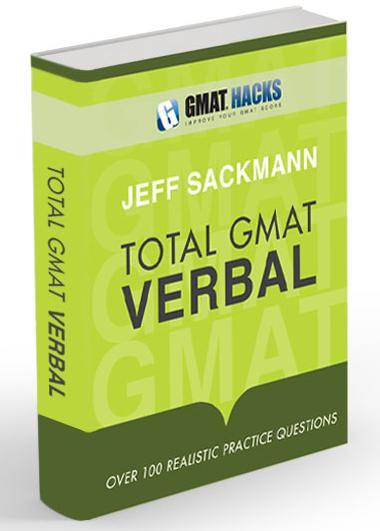
Bookshelf
|
|
Total GMAT Math Jeff's complete Quant guide, on sale now! |
|
|
Total GMAT Verbal Everything you need to ace GMAT Verbal! |
1,800 Practice Math Questions
Buy Jeff's books at Amazon.com

GMAT Official Guide, with IR
OG Math | OG Verbal
OG12 & Quant Rev solutions!
GMAT Question of the Day
Beginner's Guide to the GMAT
GMAT Hacks Affiliate Program

Recent Hacks

Categories
- General Study Tips
- Goals and Planning
- CAT Strategy
- The Mental Game
- GMAT Math Strategy
- GMAT Math Topics
- Mental Math
- Data Sufficiency
- Critical Reasoning
- Reading Comprehension
- Sentence Correction
- Analytical Writing Assessment
- Integrated Reasoning
- IR Explained
- Business School Admissions
- GMAT Prep Resources
- Practice Questions
- Total GMAT Math
- Total GMAT Verbal
- GMAT 111

Sentence Correction Choice (A)
| You should follow me on Twitter. While you're at it, take a moment to subscribe to GMAT Hacks via RSS or Email. |
Here's a fun fact from the makers of the GMAT: the five answer choices are equally distributed in the question pool. Put another way, there are just as many (A)'s as (B)'s, (D)'s as (E)'s, etc.
That doesn't mean you should count your answers as you go through the test--not only would it be silly, but it would miss the point. There's no guarantee that your 78 GMAT questions will consist of 15 or 16 of each of the five choices. But there are some useful tips that you can take away.
Sentence Correction Choices
I've never studied it, but I suspect that if we were to track GMAT students as they progressed from novice status to test day, we could watch them choose more and more (A)'s in Sentence Correction. Here's why.
(If you're new to the GMAT: in SC questions, (A) simply repeats the sentence. In effect, selecting choice (A) is saying that the sentence is correct as is.)
Early on, you get in the habit of looking for mistakes. That's the right way to go about a SC question. Really, it's one of the only ways. But it has its dangers. If you're looking for errors, you may find them even if they aren't there.
Thus, when you are committed to finding an error, you'll find one whether its in the original sentence or not, and you'll eliminate (A) without thinking too much about it. Then, if all of the other choices are bad, you'll choose the least offense of the remaining four answers.
And, in the process, you'll never pick (A).
The Choice (A) Learning Curve
Eventually, you see the pattern. (A) comes up just as often as any other choice, but that doesn't mean it's only correct when the sentence glistens with correctness and efficiency.
To me, the toughest SC questions are those where all of the choices are inefficient, or just clunky. The same reading skills that make you better at Reading Comprehension and Criticial Reasoning can be harmful on SC because you are that much more ready to eliminate a choice just because it's not well written.
You must realize, though, that when all of the choices are undesirable, (A) is just as likely as the other choices to be correct. In fact, it seems to me that it's a little more likely than the others in those cases. Maybe that's just mental--an overcorrection for throwing (A) out in the first place--but it may be a useful way for to keep (A) in mind even when it isn't particularly well-phrased.
Wrong Answers are Wrong
If you do come to a SC question where all of the choices look wrong, turn your focus away from clarity and efficiency. Hone in on more technical grammatical rules, such as verb tense and parallelism. If one choice has an incorrect verb tense and another is inefficienct, the first will never be correct, while the second could be.
In a sense, there is a hierarchy of errors. The hard-and-fast grammar rules, like verbs and modifiers and some idioms, automatically eliminate a choice. Excessive wordiness and inefficient expression...well, in some cases they differentiate between two decent choices. In other cases, there's only one choice left standing after you eliminate all of the technically wrong choices.
With enough practice, you'll look at each choice in two ways. First, you'll see whether it must be wrong. Second, you'll see whether it could be wrong. To keep of my work, I jot down "A B C D E" on my scratch paper for each SC question. If a choice is clearly wrong, I put an "X" through that choice. If a choice might be wrong, I put a "?" next to it.
Thus, at a glance, even if I think all five choices could be wrong, I can look back only at those choices that I assigned question marks to. It saves time, and keeps me focused on the choices that matter.
And, to bring us back full circle: those question marks serve as a reminder that (A) might be right. Even if it's not perfect.
About the author: Jeff Sackmann has written many GMAT preparation books, including the popular Total GMAT Math, Total GMAT Verbal, and GMAT 111. He has also created explanations for problems in The Official Guide, as well as 1,800 practice GMAT math questions.
 |
Total GMAT Verbal
The comprehensive guide to the GMAT Verbal section. Recognize, dissect, and master every question type
you'll face on the test. Everything you need, all in one place, including 100+ realistic practice questions. |